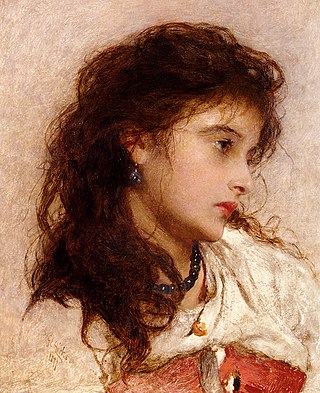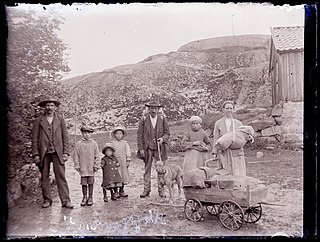
The Romani people, also known as the Roma, are an ethnic group of Indo-Aryan origin who traditionally lived a nomadic, itinerant lifestyle. Linguistic and genetic evidence suggests that the Roma originated in the Indian subcontinent, in particular the region of Rajasthan. Their first wave of westward migration is believed to have occurred sometime between the 5th and 11th centuries. They are thought to have arrived in Europe around the 13th to 14th century. Although they are widely dispersed, their most concentrated populations are believed to be in Bulgaria, Hungary, Romania, Serbia and Slovakia.

Irish Travellers, also known as Pavees or Mincéirs, are a traditionally peripatetic indigenous ethno-cultural group originating in Ireland.
Pikey is an ethnic slur referring to Gypsy, Roma and Traveller people. It is used mainly in the United Kingdom and in Ireland to refer to people who belong to groups which had a traditional travelling lifestyle. Groups referred to with this term include Irish Travellers, English Gypsies, Welsh Kale, Scottish Lowland Travellers, Scottish Highland Travellers, and Funfair Travellers. These groups consider the term to be extremely offensive.
Angloromani or Anglo-Romani is a mixed language of Indo-European origin involving the presence of Romani vocabulary and syntax in the English used by descendants of Romanichal Travellers in the United Kingdom, Australia, Canada, New Zealand, United States, and South Africa.

The Romanichal are a Romani subgroup within the United Kingdom and other parts of the English-speaking world. Most Romanichal speak Angloromani, a mixed language that blends Romani vocabulary with English syntax. Romanichal residing in England, Scotland, and Wales are part of the Gypsy, Roma, and Traveller community.
The term English Travellers may refer to the following itinerant groups indigenous to England:

Anti-Romani sentiment is a form of bigotry which consists of hostility, prejudice, discrimination, racism and xenophobia which is specifically directed at Romani people. Non-Romani itinerant groups in Europe such as the Yenish, Irish and Highland Travellers are frequently given the name "gypsy" and as a result, they are frequently confused with the Romani people. As a result, sentiments which were originally directed at the Romani people are also directed at other traveler groups and they are frequently referred to as "antigypsy" sentiments.

Norwegian and Swedish Travellers, commonly known as Romanisael, are a group or branch of the Romani people who have been resident in Norway and Sweden for some 500 years. The estimated number of Romanisael in Sweden is 65,000, while in Norway, the number is probably about 10,000.

The Finnish Kale are a Romani subgroup who live primarily in Finland and Sweden. Their main languages are Finnish, Swedish and Finnish Romani. Kalo/Kale is the collective name for traveler people in Finland.

The Romani people have several distinct populations, the largest being the Roma and the Calé, who reached Anatolia and the Balkans in the early 12th century, from a migration out of the Indian subcontinent beginning about 1st century – 2nd century AD. They settled in the areas of present-day Turkey, Greece, Serbia, Romania, Croatia, Moldova, Bulgaria, North Macedonia, Hungary, Albania, Kosovo, Bosnia and Herzegovina, Czech Republic, Slovenia and Slovakia, by order of volume, and Spain. From the Balkans, they migrated throughout Europe and, in the nineteenth and later centuries, to the Americas. The Roma population in the United States is estimated at more than one million.
Scottish Romani are the Romani people of Scotland. This includes Romanichal and Lowland Roma.

The Kale are a Romani subgroup predominantly found in northwestern Wales, specifically in the Welsh-speaking areas. Many Kale claim to be descendants of Abram Wood, the first Rom to reside permanently and exclusively in Wales in the early 18th century, although Romanichal have appeared in Wales since the 16th century. Romanichal inhabit South Wales and North East Wales.
The Romani people are known by a variety of names, mostly as Gypsies, Roma, Tsinganoi, Bohémiens, and various linguistic variations of these names. There are also numerous subgroups and clans with their own self-designations, such as the Sinti, Kalderash, Boyash, Manouche, Lovari, Lăutari, Machvaya, Romanichal, Romanisael, Kale, Kaale, Xoraxai and Modyar.

Romani Americans are Americans who have full or partial Romani ancestry. It is estimated that there are one million Romani people in the United States. Though the Romani population in the United States has largely assimilated into American society, the largest concentrations are in Southern California, the Pacific Northwest, Southwestern United States, Texas, Louisiana, Florida and the Northeast as well as in cities such as Chicago, Cleveland, and St. Louis.

There are a number of traditionally itinerant or travelling groups in Europe who are known as Travellers or Gypsies.

White: Gypsy or Irish Traveller is an ethnicity classification used in the 2011 United Kingdom Census. In the 2011 census, the White: Gypsy or Irish Traveller population was 63,193 or about 0.1 percent of the total population of the country. The ethnicity category may encompass populace from the distinct ethnic groups of Romanichal Travellers or Irish Travellers, and their respective related subgroupings, who identify as, or are perceived to be, white people in the United Kingdom.
Leeds University Library's Gypsy, Traveller and Roma Collections are one of the five Designated collections held by the Brotherton Library at the University of Leeds. The collections contain an extensive range of international books, manuscripts and archives relating to Gypsy, Traveller and Roma culture. The majority of the materials do not originate from within these communities, instead they encapsulate external representations.
Crystal's Vardo is an English theatre production written and directed by Suzanna King for children aged 7+, about the impact of being bullied at school on a young Gypsy girl's life. It uses dance, drama, humour and music, in a hybrid of theatre, storytelling, historical reconstruction and political education, to describe the culture and histories of Gypsy, Roma and Traveller communities. The play "remains entertaining while also raising awareness about the racism and injustice faced by Gypsies and Travellers today."
Gypsy, Roma and Traveller is an umbrella term used in the United Kingdom to represent several diverse ethnic groups which have a shared history of nomadism. In the phrase GRT, The Gypsy grouping encompasses Romani subgroups that have resided in Britain since the 16th century, the Romanichal and Kale but also those from other Romani subgroups. The British government and British GRT rights groups understand the term Roma as encompassing more recent Romani migrants from mainland Europe and their descendants. Travellers include Irish Travellers (Mincéirí) residing in Britain and Northern Ireland and the traditional travelling people indigenous to Britain such as Scottish Travellers. Although these groups' lifestyles traditionally involved travel, most GRT people now live in houses or permanent caravan berths.















